Kitchen lighting is essential for safely following recipes and completing tasks in a timely manner. It can be difficult deciding what color of light best suits your kitchen, but we’ve done all the work.
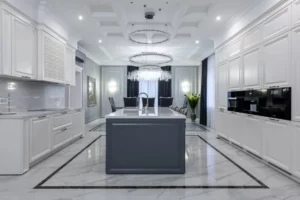
The kitchen is a space with warm colors that should be highlighted by bulbs. If you have an ordinary light, it will take on the color of its surroundings and lose impact as well- so stick to white or yellow lights! These types also make people hungry – perfect for those dinner parties where everyone talks over each other while eating their meal (you know how these things go). One more thing worth noting: 7k – 8K Lumens are recommended when designing lighting schemes in kitchens; just remember not too bright though because anything above this can start getting uncomfortable if there isn’t any circulation throughout your room.
If you’re still wondering about kitchen lighting, we’ve got the answers! Learn what lumens are and how they affect your bulb’s wattage.
Table of Contents
Effect Of Color On Your Kitchen
The impact of light on your kitchen is huge. It can make or break the design and functionality, so it’s important to choose wisely! There are many different colors available from which you’ll have no problem finding one that suits whatever look/needs there may be for this space in mind – whether yellow-hued warmth when cooking at night time; deepened autumnal hues perfect during fall months; or even winter white if desired.
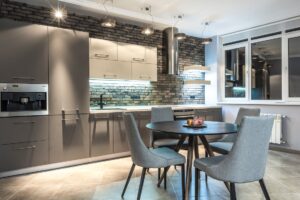
Kitchen lighting is an important consideration when designing a space. The best way to ensure there’s adequate visibility while cooking? Choose lights that fall somewhere in between white and dark – like warm LED or fluorescent bulbs.
What are Lumens to Watts?
Lumens are the brightness of a light bulb. You can compare them to how bright outside lighting is, and each type has its own set of lumen values based on wattage or power consumption for different levels of illumination in your home’s interior design needs.
The perfect light for your kitchen is out there! But, it can be difficult to find. We have found some great bulbs that will work well in any size or type of space–and at various wattages listed below (and more!). Look through our selection carefully so you don’t get disappointed when choosing what’s right for YOU 🙂 The recommended lumens range from 7K – 8k depending on how much natural sunlight shines through windows nearby, but if not then just take into account whatever quantity available throughout day/nighttime hours according to t0 each specific location.
Incandescent Light Bulbs

When shopping for a light bulb in your kitchen, it is best to go with an incandescent one. These bulbs give off more than enough brightness and have the added bonus of being able to reflect heat from cooktop surfaces so you don’t burn anything! Soft white colors are perfect if that’s what YOU want but there are also plenty of other options available including cool daylight (perfect) or warm white which would be better suited towards illuminating someone else’s space instead – say their dining room table?
What is a Halogen Bulb?

Halogen bulbs are the best type of lightbulb for your home. These cool white incandescent lights tend to last longer and give off more lumens than their traditional counterparts, which is why they’re so popular in track illumination or kitchen applications where you need high-quality but not intense brightnesses at lower power consumption rates like what’s typically seen on dimmer switches (which can also be powered by these types). In general though – if it needs a warm short blastoff Sunlit warmth throughout an entire room-, then go ahead.
CFL Light Bulbs

CFLs are an excellent choice for anyone who wants to save money and electricity. These bulbs use far less energy than traditional lightbulbs, so they’re perfect if you have limited resources as we do! The cool white color of these lights makes it feel more Caffeine-worthy in our kitchen without having too much harsh sunlight coming through the windows during hot summer days.
LED Light Bulbs

LED bulbs use a semiconductor to emit light when electrical current flows through them. They come in various colors and have remotes that control how warm or cold the bulb’s lighting output will be, making these perfect for kitchens where you want some variation during cooking hours.
Red-Toned Light Bulbs

If you’re looking for a way to spice up your kitchen and stimulate conversation, check out these red-toned light bulbs. They come in both LED and regular incandescent varieties so there’s something available no matter what kind of event it is that calls upon them.
How To Light A Kitchen?
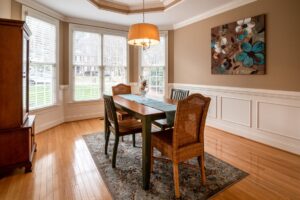
Kitchen lighting is an often overlooked but crucial aspect of designing your perfect kitchen. From track lights that provide task-specific illumination to pendant styles that can be lowered or raised depending on what you need at any given moment, there’s no shortage when it comes down to choosing how best to light up this room.
In the kitchen, pendant lighting is a great way to provide warm illumination over an island or bar. It also hangs down enough so that it can be used when cooking at night without any overhead lights being on in your house during daytime hours – which helps save energy. For added warmth within this space while using these fixtures as well you may want to consider adding another form of facing off against nearby surfaces like counters by having small table lamps placed strategically throughout instead; these sorts will offer just what is needed.
Types of Lighting you Need to Know
Accent:

Consider these flourishes to be the cherry on top of your well-designed kitchen: toe kick lights, cabinet illumination, and any other light that might accentuate favorite elements. They also could cross over into ambient or task lighting as well.
Ambient:
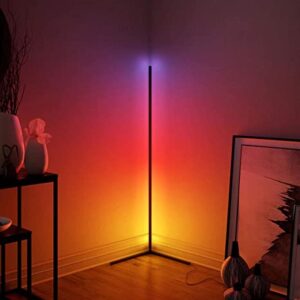
choose the perfect lighting for your space. Choose from chandeliers, pendant lights or recessed fixtures to cast light evenly on every corner of any room in which you install them.
Task:
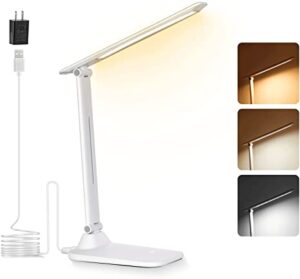
Kitchen task lighting is an essential part of any modern cooking space. The right kind can make all the difference between being able to safely prepare meals and easily spot ingredients on a shelf, but it’s often difficult for beginners who don’t know what they’re looking for in this area since there are so many options available! A few popular choices include strip lights or puck-style lamps that provide bright illumination wherever you need it most – just be sure not to let them shine into your eyes if possible because too much light could cause discomfort (especially when working late hours).
Under-Cabinet Lighting
Kitchens can feel a little dark and dreary without the right lighting to navigate throughout your space. Accent lights are great for accentuating certain features, but they often leave shadows under cabinets or while you’re trying not to cut yourself on an exposed blade of grass inside one lit up too much! If the ambient light isn’t enough though task lamps will provide ample illumination where needed so that everything is easily visible no matter what area in which it’s located – especially when preparing meals where every detail counts including seeing if there might be any nearby objects susceptible to toppling over onto pots+kettle.

When you’re looking for kitchen under cabinet lighting, it’s important that the fixture matches your needs and style. A great salesperson can help with this!
A variety of different options are available in terms of size (size doesn’t matter as much when considering LED), material- whether metal/stainless steel vs plastic; brightness level which measures Lumens per square foot but also has other factors like color temperature included so make sure there isn’t too much flicker before choosing one…and lastly map out an entire scheme just from what prep space we have available at home.
Strip Lights:
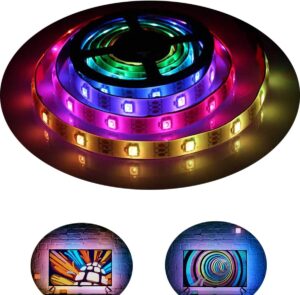
LED strip lights are perfect for illuminating low cabinets that don’t receive much natural light. They’re also used to illuminate counter spaces under kitchens and other areas where it’s difficult or impossible to install overhead track fixtures, so you can have full visibility of your contents at all times.
Puck Lights:

The puck light is a great mood and countertop illuminator that can be used to create different effects, such as scallops or spotlights.
Where Should You Aim Downlights For A Kitchen?
The perfect place for downlights is where you will need them most, so aim those lights over your kitchen table and countertops. It’s also good to put some outside on an area like stairways since they can provide light when we climb up or down from one floor of our home into another.
How Should You Space Downlights?
When you’re not using any other sort of lighting, these can provide a soft glow over an island or table. Place them about 1/3rd the width apart and they will give off just enough light to read by.
Should Pendant Lights Be Centered Over The Kitchen Island?
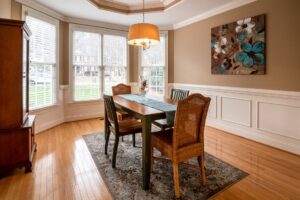
It all depends on your needs and the look you’re going for. If the light is what’s needed in a space, then there are many ways to go about achieving that with pendant lighting- from adding just one or two lights over an island as well as placing them evenly across different areas of kitchen countertops like sinks or appliances so they shine down onto these spots at night time while people prepare food during the day.
Setting the Mood in the Kitchen
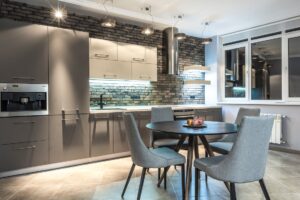
Lighting can change your mood! That’s right, the color temperature of light is something to think about when you’re looking for a good night’s sleep or just trying not to be too spent after work. If low-temperature lights make us sleepy and high-temperature ones give energy boosts – what does this mean? It seems like there might actually exist an ideal “mood” type in terms of how much serotonin (or any other hormone) gets released by our bodies depending upon its Colour Temperature: cold blues are linked with more calming effects while warm red.
You can use both high- and low Color Temperature lights in your kitchen. It’s good to layer decorative bulbs with a warm amber glow for a space that already has cool whites and daylights, but it might be better if you install a dimmer switch so that there is more control over the brightness of light fixtures.
In order to prepare your meals properly, you should turn off any cool lights that may be shining onto the stovetop. If there is no other lighting insight and it’s just yourself cooking by lantern light or only one lamp on at night then maybe these low-wattage bulbs are perfect for what we need but when preparing food during daytime hours (or if I’m making dinner) – especially with an open layout kitchen like ours which has lots of windows facing east so natural ample sun shines through all throughout summertime — turning that brighter whiteendantiate
I love using color-changing LEDs because not only can they change temperatures.
Final Verdict
When shopping for a light bulb, it is important to keep in mind what kind you need. A kitchen should have between 7,000 and 8 thousand lumens of perfect lighting – which can be achieved with many types from incandescent lights all the way to LED bulbs. Warm white color hues work best when installed correctly throughout your house so don’t forget them during remodeling projects or new construction builds.
We’ve got you covered with these other kitchen guides:
FAQ’s
Q. What are the best lights for the kitchen?
Answer:
There are many different types of kitchen lights available on the market, and it can be difficult to choose the best option for your space. However, there are a few things to keep in mind that will help you make the best decision.
First, consider the size of your kitchen and the number of light fixtures you will need. If you have a small kitchen, you may only need one or two light fixtures. However, if you have a larger kitchen, you may need several light fixtures to evenly distribute light throughout the space.
Second, think about the type of light you want in your kitchen. You may prefer bright white light for tasks like cooking and prepping food, or softer ambient light for relaxing.
Q. What is the brightest LED light for the kitchen?
Answer:
Kitchen lights come in a variety of shapes and sizes, but the one thing they all have in common is that they need to be bright. When it comes to LED kitchen lights, the brightest option is a light that uses direct current (DC).
Most LED kitchen lights use alternating current (AC), which is not as bright as DC. If you’re looking for the brightest LED kitchen light, make sure to find one that uses DC.
When shopping for a new LED kitchen ceiling light, it’s important to consider the brightness rating. The higher number means that these lights will be more illuminating and thus perfect if you want adequate illumination in your cooking area or dining room.
Q.What type of light is used in the kitchen?
Answer:
There are a few different types of light fixtures that can be used in the kitchen. The most common type is the overhead light, which can provide general lighting for the entire room. These lights are often fluorescent or LED, and they come in a variety of shapes and sizes. Another popular option is under-cabinet lighting, which can help to illuminate countertops and work areas. This type of lighting is often halogen or LED, and it is available in both tape and puck forms. Finally, task lighting is also a good option for the kitchen. This type of lighting is designed to provide focused light for specific tasks, such as cooking or food prep. Task lights can be either incandescent or LED.
Q. What is a kitchen downlight?
Answer:
Kitchen downlights are lights that are installed in the ceiling and directed towards the counter or table below. They provide task lighting for cooking or preparing food and can make a kitchen feel brighter and more spacious.
There are many different types of kitchen downlights available, including LED, halogen, and fluorescent. It is important to choose the right type of light for your needs, as some lights may be brighter or warmer than others.
When choosing kitchen downlights, it is important to consider the size of the room and how much light you need. If you have a large kitchen with a lot of counter space, you will likely need more light than if you have a small kitchen with limited counter space.
Q. What can I use instead of downlights?
Answer:
In a well-lit room, downlights are often positioned in the ceiling to light everything. However when ambient lighting is added as an extra layer of illumination on top of other sources such as lamps and candles; use white glass or fabric to shade your lights for better spreadability across all areas within its range.

